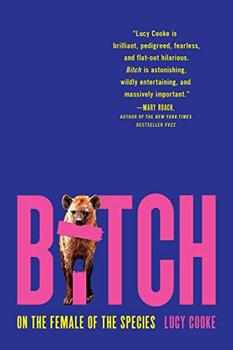Summary | Excerpt | Reviews | Beyond the Book | Readalikes | Genres & Themes | Author Bio

On the Female of the Species
by Lucy Cooke
Testosterone is indeed a potent hormone. If delivered at the right time, it has the power to reverse the gonadal sex of female fish, amphibians and reptiles. In mammals, it can't force a full sexual U-turn but marinating a female fetus in androgens radically alters the formation of her genitals. Experiments in the 1980s created female rhesus monkeys with a penis and scrotum 'indistinguishable from that of males' by exposing them to testosterone at key stages during their gestation.
Sure enough, when tested, female spotted hyenas revealed rocketing levels of testosterone during their pregnancy. But, with no testes in sight, what could be the source of this 'male' hormone, and how does the developing female fetus manage to survive its omnipotence yet still develop a functioning reproductive system?
The answers lie in how testosterone is synthesized. All of the sex hormones – oestrogen, progesterone and testosterone – originate as cholesterol. This steroid is converted by the action of enzymes to progesterone, a hormone commonly associated with pregnancy and the precursor to androgens, which are, in turn, the precursors to oestrogens. These 'male' and 'female' sex hormones can convert from one to the other and are present in both sexes.
'There's no such thing as a "male" hormone or a "female" hormone. It's a common misconception. We all have the same hormones,' Christine Drea revealed to me over Skype. 'All that differs between males and females are the relative amounts of enzymes that convert the sex steroids from one to another and the distribution and sensitivity of hormone receptors.'
Drea is a professor at Duke University and knows more than most about the hormonal politics of female sexual differentiation. She's devoted her career to studying a suite of so-called 'masculinized' females, including the spotted hyena along with meerkats and ring-tailed lemurs.
Drea is part of the team that established the source of the pregnant hyena's testosterone. It comes from a lesser-known androgen called androstenedione, or A4, that's actually produced by the pregnant female's ovaries. This form of androgen is known as a precursor hormone, as it converts to either testosterone or oestrogen following the action of enzymes in the placenta.
In most pregnant mammals carrying daughters, A4 is preferentially transformed into oestrogen, but in the spotted hyena it transforms to testosterone instead. This 'male' hormone then exerts its influence on the developing genitals and brain of the female fetus, transforming both her pudenda and her post-natal behaviour.
Historically, A4 aroused little interest as a sex hormone; it was dismissed as 'inactive' for not binding to known androgen receptors. But receptors are now being located that suggest it does have direct action and, more crucially, its effects may differ depending on the sex of the fetus.
'There's a growing body of literature suggesting that hormones can have sexually differentiated effects in different animals. It's all about amount, duration and timing,' Drea articulated.
Drea's work clearly demonstrates that making a female is far from a 'passive' process, and one in which androgens can play an active role. 'Testosterone is not a "male" hormone. It is just a hormone that is more obviously expressed in males than females,' she reiterated.
It's clear to Drea that the female hyena's sexual development must also be under dynamic genetic control to resist the overpowering effects of an excess of androgens and still create a functional, if eccentric, reproductive system. But how is still much of a mystery. The functional genetic steps of how to actually make female reproductive organs are still poorly understood when compared to the male.
This bias in our understanding comes from Jost's famous but flawed theory of sex differentiation, which only ever explained how you differentiate a male and never questioned how the female is created. The idea that any development process could be 'passive' is clearly quite ludicrous – ovaries require just as much active assembly as do testes. Yet for fifty years the 'default' female system went unstudied.
Excerpted from Bitch by Lucy Cooke. Copyright © 2022 by Lucy Cooke. Excerpted by permission of Basic Books. All rights reserved. No part of this excerpt may be reproduced or reprinted without permission in writing from the publisher.
Your guide toexceptional books
BookBrowse seeks out and recommends the best in contemporary fiction and nonfiction—books that not only engage and entertain but also deepen our understanding of ourselves and the world around us.